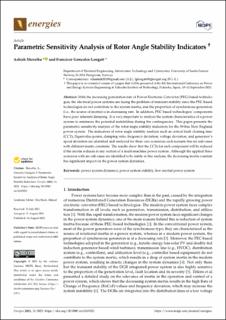Parametric sensitivity analysis of rotor angle stability indicators
Journal article, Peer reviewed
Published version
Permanent lenke
https://hdl.handle.net/11250/2986164Utgivelsesdato
2021Metadata
Vis full innførselSamlinger
Originalversjon
Shrestha, A. & Gonzalez-Longatt, F. (2021). Parametric Sensitivity Analysis of Rotor Angle Stability Indicators. Energies, 14(16), Artikkel 5023. https://doi.org/10.3390/en14165023Sammendrag
With the increasing penetration rate of Power Electronic Converter (PEC) based technologies, the electrical power systems are facing the problem of transient stability since the PEC based technologies do not contribute to the system inertia, and the proportion of synchronous generators (i.e., the source of inertia) is in decreasing rate. In addition, PEC based technologies’ components have poor inherent damping. It is very important to analyze the system characteristics of a power system to minimize the potential instabilities during the contingencies. This paper presents the parametric sensitivity analysis of the rotor angle stability indicators for the 39-bus New England power system. The indicators of rotor angle stability analysis such as critical fault clearing time (CCT), Eigenvalue points, damping ratio, frequency deviation, voltage deviation, and generator’s speed deviation are identified and analyzed for three case scenarios; each scenario has six sub-cases with different inertia constants. The results show that the CCTs for each component will be reduced if the inertia reduces at any section of a multi-machine power system. Although the applied three scenarios with six sub-cases are identified to be stable in this analysis, the decreasing inertia constant has significant impact on the power system dynamics.

